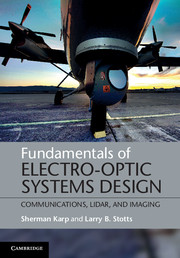Book contents
- Frontmatter
- Contents
- Preface
- Notation
- 1 Genesis of electro-optic systems
- 2 Role of electromagnetic theory in electro-optics systems
- 3 Photo-detection of electromagnetic radiation
- 4 Metrics for evaluating photo-detected radiation
- 5 Contrast, visibility and imaging
- 6 Signal modulation schemes in optical communications
- 7 Forward error correction coding
- 8 Modern communications designs for FOC/FSOC applications
- 9 Light detection and ranging
- 10 Communications in the turbulence channel
- 11 Communications in the optical scatter channel
- Appendix A Two-dimensional Poisson processes
- Appendix B Propagation of finite beams in water
- Appendix C Non-Lambertian scattering
- Appendix D Communications noise sources besides signal/background shot noise
- Index
- References
2 - Role of electromagnetic theory in electro-optics systems
Published online by Cambridge University Press: 05 February 2013
- Frontmatter
- Contents
- Preface
- Notation
- 1 Genesis of electro-optic systems
- 2 Role of electromagnetic theory in electro-optics systems
- 3 Photo-detection of electromagnetic radiation
- 4 Metrics for evaluating photo-detected radiation
- 5 Contrast, visibility and imaging
- 6 Signal modulation schemes in optical communications
- 7 Forward error correction coding
- 8 Modern communications designs for FOC/FSOC applications
- 9 Light detection and ranging
- 10 Communications in the turbulence channel
- 11 Communications in the optical scatter channel
- Appendix A Two-dimensional Poisson processes
- Appendix B Propagation of finite beams in water
- Appendix C Non-Lambertian scattering
- Appendix D Communications noise sources besides signal/background shot noise
- Index
- References
- Type
- Chapter
- Information
- Fundamentals of Electro-Optic Systems DesignCommunications, Lidar, and Imaging, pp. 19 - 40Publisher: Cambridge University PressPrint publication year: 2012



